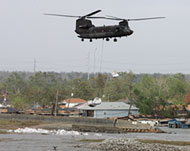New Orleans’ sinking worsens
The southern US city of New Orleans, devastated by last year’s Hurricane Katrina, is sinking faster than previously thought, scientists say.

The research, reported in Nature science journal, was based on radar data of the city compiled in the three years before Katrina.
It found that the city was sinking on average 6mm a year, but up to 29mm a year in areas near the city’s levees.
Tim Dixon of the University of Miami Rosenstiel School of Marine and atmospheric Science, said: “What we found is that some of the levee failures in New Orleans were places where subsidence was highest.”
‘Death traps’
Scientists said the rate of subsidence explained why some areas of New Orleans were so badly affected by the hurricane – as the ground sinks the level of protection offered by the levees lowers.
|
“I think those areas are death traps. I don’t think those areas should be rebuilt” Tim Dixon, University of Miami Rosenstiel School of Marine and Atmospheric Science |
The city’s Mississippi River Gulf Outlet has sunk by more than a metre since its construction 30 years ago, which explains why water poured over the levee and part of it failed.
Dixon said that the the subsidence in some areas was so bad he did not think that they should be rebuilt.
“I think those areas are death traps. I don’t think those areas should be rebuilt,” he said.
Reasons unclear
It is not clear why the subsidence rate has risen so rapidly.
Some scientists said it could be natural seismic shifts, while others blame overdevelopment and drainage of the city’s marshlands.
 |
|
Engineers are trying to rebuild |
Regardless of the causes, scientists said the rapid rate of subsidence should be taken into account by authorities rebuilding the city’s flood defences.
More than 1,300 people died and damage estimated at billions of dollars was caused when Hurricane Katrina devastated the city in August.
The study comes as US military engineers are to release a report on the alleged engineering and design failures that led to the disaster.
The 6,000-plus page report by the Interagency Performance Evaluation Task Force (IPET) will examine engineering details and failures before the disaster.